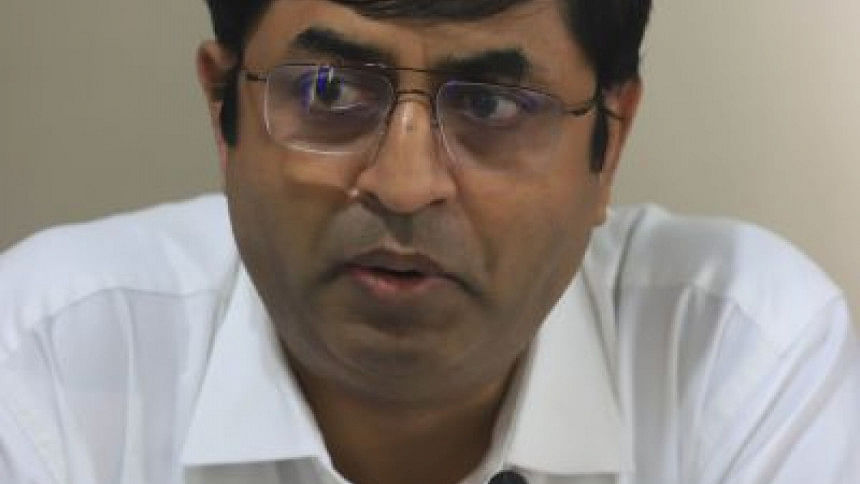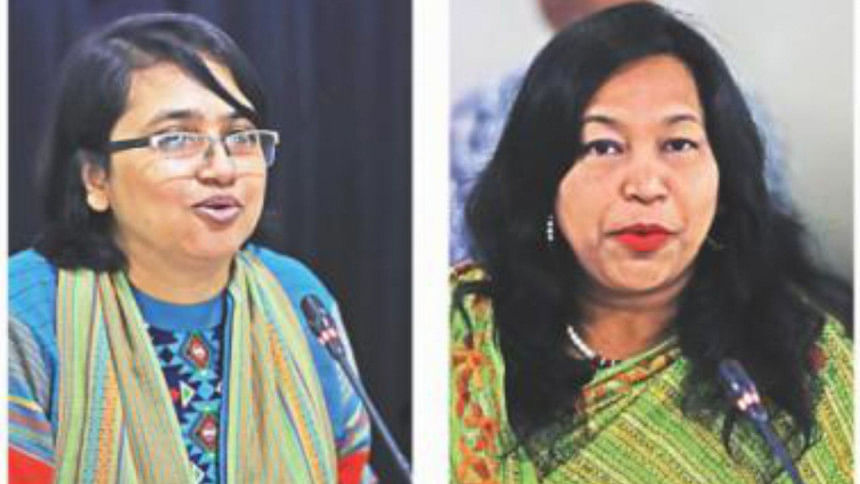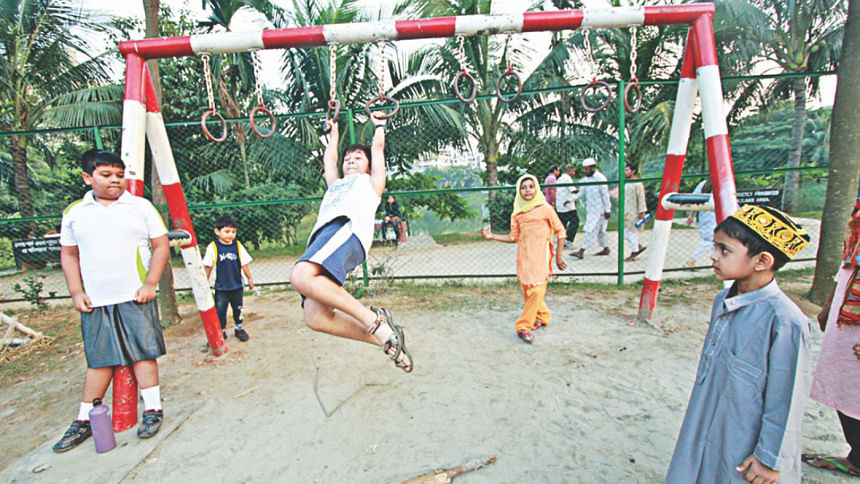Who are the playgrounds for, if not the children?

The case of the Dhanmondi-8 public playground is emblematic of the problem with Dhaka's open spaces, parks and playgrounds. De facto taken over by Sheikh Jamal Dhanmondi Club, it has, for years, been used exclusively for its trainings and practices.
In April 2014, the club sued activists and organisers of Bangladesh Poribesh Andolon (BAPA) and Bangladesh Environmental Lawyers Association (BELA) among others, for entering the grounds to hold a protest. The reason for the protest was that the club had embarked on building dedicated sports facilities on the grounds for their club teams, in a blatant disregard of the fact that this is a publicly owned playing field open to everyone. Those barred from entering also happened to be Dhanmondi residents, who have every right to enter their local playground.
The club's defense, at the time, was that the playground was built for "elites" and not "commoners". It also had the support of the football and cricket governing bodies. The club had its own security guards to keep others than its own members and players away.
This occupation continues, despite a 2011 High Court order that all illegal structures be removed and the playground freed for the use of those intended—children and other residents of the area. In 2013, a show cause notice was issued by the High Court, to no avail.
"We have been unable to recover this one playground occupied by a club, which is now known by the club's name, though it is for the people. The state cannot lease out public playgrounds to clubs without providing an alternative to the local community," states Professor Adil Mohammed Khan, general secretary of Bangladesh Institute of Planners.
Abahani playground and the Kalabagan field are others which remain largely occupied by club practices, training, and tournaments for most of the week. But parks are not just vulnerable to sporting clubs. A report in The Daily Star in January 2013 noted that six different groups and societies had built numerous concrete structures in Gulshan Lake park.
"There are enough playgrounds and open spaces, though very less, but what little there is we have not been able to ensure that these be exclusively used by our children to play," says architect Iqbal Habib, joint secretary of BAPA. Open spaces are being occupied by institutions which restrict access or charge fees for entry, he adds, as well as being leased out for events such as melas, haats, and religious festivals.
Encroachment by public and private bodies was cited as the primary threat to public open spaces by Rajuk in a revised master plan for 2016-2035. In addition to spaces in private clutches as mentioned above, government agencies and ministries construct offices or community centres in parks such as the Uttara sector one park and the Nababganj park in old Dhaka.

What open spaces are left?
Only 0.07 acre of land is available for recreational use by every 1,000 residents, according to the 2013 regional development planning survey by Rajuk. This is far below the standards set by the Dhaka Metropolitan Development Plan (0.16 acre) and Rajuk's Detailed Area Plan (0.96 acre). Many of the provisions for allocation and maintenance of open spaces in the DAP, which expired in 2015, remain unimplemented.
"It is more difficult to create new playgrounds… rather, existing school fields and playgrounds can be used after school hours by local children," says Ishrat Islam, professor of urban planning at Bangladesh University of Engineering and Technology (BUET).
Other than a lack of space, arises the question of jurisdiction of existing open spaces. "Our limitation is that all these areas are not under the city corporations. Most of the playgrounds and open spaces are under Rajuk or [the] housing and public works ministry," says engineer Tariq Bin Yousuf, project director of urban resilience at Dhaka North City Corporation.
For example, largescale open spaces such as Suhrawardy Udyan and Ramna Park are under the jurisdiction of the public works department and amount to a total of 302.5 acres. The city corporations, on the other hand, maintain local level parks and playgrounds totalling about 85 acres only.
Other than existing parks and playgrounds, are unused spaces and vacant land such as the Old Airport in Tejgaon. "The old airport area is unused and should be given back to the people of Dhaka as a free open space, similar to Suharwardy Udyan. There are many spaces like this—we have to go for acquisition," argues architect Habib. Dr Md. Aminul Islam, joint secretary of the Directorate of Sports, echoes this. "The railway, for example, owns many unused open spaces. We want to involve them in our efforts to use these spaces for playgrounds and sports facilities."
Co-management by the city corporations and the local community should be a part of the solution to maintenance of parks and playgrounds, says Habib. Ensuring access to all is equally important. "The most left behind [with right to play] are young girls. These spaces should be accessible to all genders and those of all backgrounds, the young, the old, and the disabled."

Lack of access to, and security in, open spaces
The lack of open spaces has particular repercussions for children. "Rapid and unplanned urbanisation is taking a heavy toll on green [areas], parks and playgrounds of the city—posing a big threat to the physical and mental growth of the children," says Salma Akhter, professor of sociology at the University of Dhaka (DU). Laila Khondkar, director of child rights governance and child protection at Save the Children, agrees, stating, "A child's right to play is important for their holistic development."
Professor Akhter, author of a study on the right to play in Dhaka city commissioned by Save The Children, surveyed 600 residents across four residential areas—Kallyanpur slum and the Dhanmondi, DU, and Mirpur residential areas. The study surveyed both children, between the ages of eight and 14, and parents. 80 percent of the children surveyed suggested that having open spaces available in their neighbourhood would be the best way to improve their right to play situation.
Take, for example, how the variation in open spaces in two of the areas under the survey—the DU residential area and Kallyanpur slum—influences games preferred by the children. In the latter, around half of the children surveyed prefer to play electronic-based games compared to just nine percent in the former. Preferences in Dhanmondi (12 percent) and Mirpur (21 percent) were also significantly lower than in the Kallyanpur slum.
This is not surprising when it comes to access to playgrounds and sports facilities. The study notes that to play football, by far the most popular outdoor game, children in the DU area had access to open fields and those in Dhanmondi had access to rented spaces, while children in Kallyanpur slum had no field in or outside their residential area.
The DU campus has the largest amount of open space in Dhaka city, notes Akhter. On the other hand, the children of Kallyanpur slum said that as their parents were busy working during the day (in occupations such as drivers, garments workers and domestic help) and could not oversee them playing at fields outside the area. And of course, their parents cannot afford to pay for them to play at places which charged a fee, notes the study.
Another issue that came up in the study was gender. "We found girls over the age of 11 to be particularly concerned about security. Below that age, they are more concerned about lack of open spaces to play in. The security issue came up with the older girls," says Professor Akhter. The study found that girls held back from playing or wanted separate facilities because they were uncomfortable playing with older boys, faced harassment, and most importantly, faced negative attitude to them playing with boys.
Interestingly, the study also found non-availability of open spaces and playgrounds (34 percent) to be only the second key barrier to play by children. The first? 47 percent of children surveyed said that too much studies was the primary barrier to their playing outside.
In partnership with Save the Children

Recommendations
1. Implementation of laws and policies, particularly the DAP, Rajuk, and city corporation laws on allocating and maintaining open spaces
2. Authorities free parks and open fields under their jurisdiction, which have been encroached for commercial purposes
3. Decrease pressure of studies, a key barrier to children's play
4. Special measures taken for access to playgrounds and parks for children from low-income and slum communities
5. Inclusion of children's voice in creating access to open spaces
6. 1 park and 1 playground in each ward of Dhaka
7. Public-private partnership—i.e. private sector investment; linking private schools with government schools which have playgrounds and open space, subsidise or free access to nearby privately-owned fields for school children to play several times a week

 For all latest news, follow The Daily Star's Google News channel.
For all latest news, follow The Daily Star's Google News channel. 



Comments